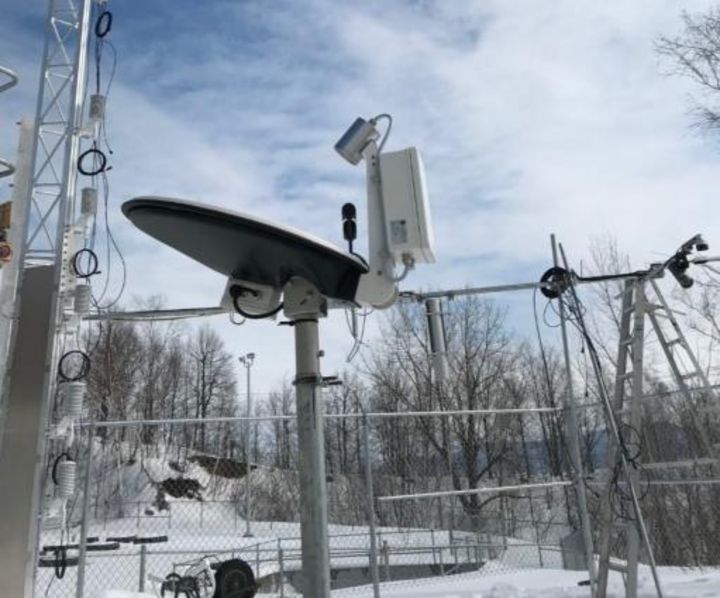
The Earth Observation System (EOS) provides the infrastructure needed to study and document ecosystems in the St. Lawrence River Valley (VFSL) in Quebec in order to develop a quantitative predictive model of system-wide interactions in the geobiosphère-climate of the region. A key aspect of EOS is its ability to include a combination of fixed facilities and a flexible mobile infrastructure to observe and analyze the Dynamic Terrestrial System (DES) in remote areas of Quebec. The VFSL climate is characterized by exceptional weather conditions (eg, ice storms), varied uses of land (urban, natural, etc.) and biodiversity flows (species loss and invasion).
The UdeS hydraulic laboratory is one of the largest in Canada. It is used as much for the courses as for the research or the realization of expertises. Numerous assemblies and several channels allow the visualization and the experimentation of almost all the phenomena of the hydraulics with free surface and under pressure. It includes a 40 hp pump, a charging system, a gauging station, channels, numerous valves and a wave channel. Measuring instruments using the latest technologies, such as acoustic doppler velocimetry, are connected to computerized data acquisition systems.
The hydraulics laboratory of the civil engineering department has several equipment to reproduce flows with free surface and load. It includes a 40 hp pump, a charging system, a gauging station, channels, numerous valves and a wave channel. Measuring instruments using the latest technologies, such as acoustic doppler velocimetry, are connected to computerized data acquisition systems. As part of research activities, specific editing can be done. Currently, we can observe a test bench to assess, in full size, the hydraulic capacity of the storm sewer grilles.
LIASHyC aims to be a world reference in the field of complex hydrogeological systems through the quality and relevance of its research and innovation, training and transfer activities. The research and innovation program focuses on fractured media hydrogeology, hydrogeology of northern and alpine regions, and characterization of hydrogeological heterogeneities. LIASHyC consists of the following parties:
- Institute of Earth Sciences of the UNIL (ISTE-UNIL)
- Center of Hydrogeology and Geothermal Energy of UNINE (CHYN-UNINE)
- Center Eau Terre Environnement of the INRS
- Department of Geology and Geological Engineering of Laval University
The microanalysis laboratory offers the scientific community, businesses and industry a characterization service for natural and synthetic materials. The laboratory operates a CAMECA SX-100 electronic microprobe and a JEOL 840-A scanning electron microscope (SEM). The laboratory also operates a Siemens D5000 X-ray diffractometer.

The hydrology, hydraulics and environment research complex is a unique research infrastructure in Canada. The research complex, located outside the main campus of the University of Sherbrooke, consists of an experimental watershed and an experimental river. Covering an area of approximately 0.4 ha, the watershed is 100 m long and varies in width from 30 m at its outlet to about 50 m at its widest point. The bottom and the walls are made up of an assembly of concrete walls and geomembranes to ensure complete watertightness of the basin. The depth of the basin varies between 3 m at its outlet to almost 5 m upstream. The basin is filled with mixed soil taken from the site and made up of till, sand and gravel with spatial heterogeneities. A groundwater collection system with drainage pipes and valves is used to control the water table. A set of instruments and sensors include rain gauges, soil moisture probes, piezometers, pressure monitors, lysimeters, a weather station and a snowpack analyzer which provides a detailed portrait of the state and flux variables in the watershed.
The experimental river is made up of a dynamic river channel 3 m wide and 50 m long with an initial slope of 0.5%. The canal can wind freely in a valley 20 m wide. The corridor is filled with a mobile substrate at least 1 m thick which allows to modify the shape, the slope, the roughness and the topography. An impermeable membrane is placed under the bed and the banks of the canal to minimize water loss by infiltration. The backfill material is composed of a mixture of gravel/rounded sand. The river operates as a closed circuit system. The water, which circulates in a loop, is conveyed by two variable speed centrifugal pumps totaling 0.8 m3/s to a supply channel and a head tank and will flow into the experimental river via a weir. The depth of flow at the downstream end of the river is controlled by a flow valve, after which the water flows into a sedimentation basin and then to the pumping basin. The transported sediments are collected in the sedimentation basin and will be transported/stored upstream via the sediment recirculation system.
The infrastructure will be accessible as a priority to researchers who obtained the grant that allowed the construction, some of which are members of CentrEau, as well as to collaborating researchers. Researchers who do not collaborate with the principal investigators will also be able to use the infrastructure. Charges may apply.